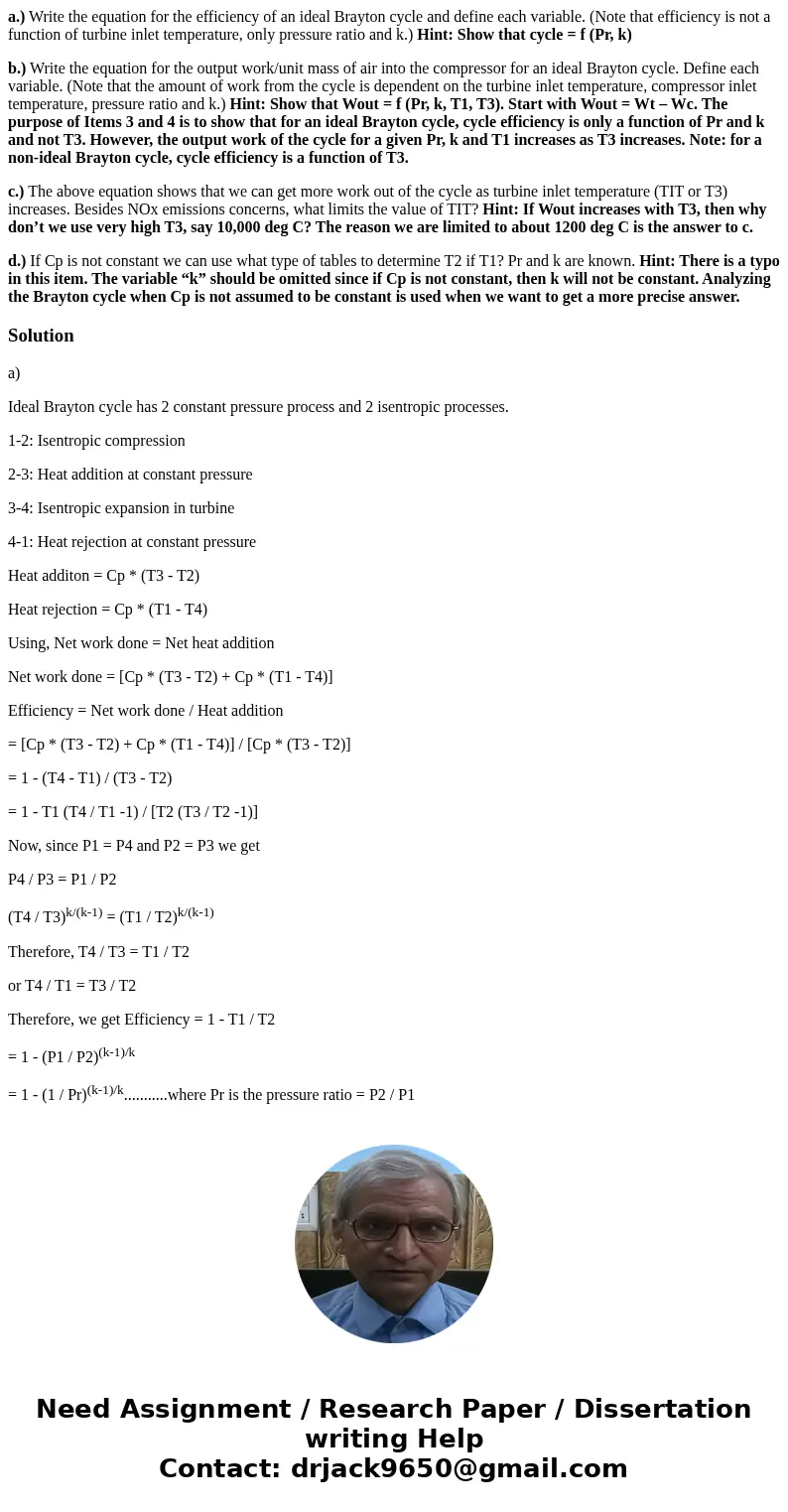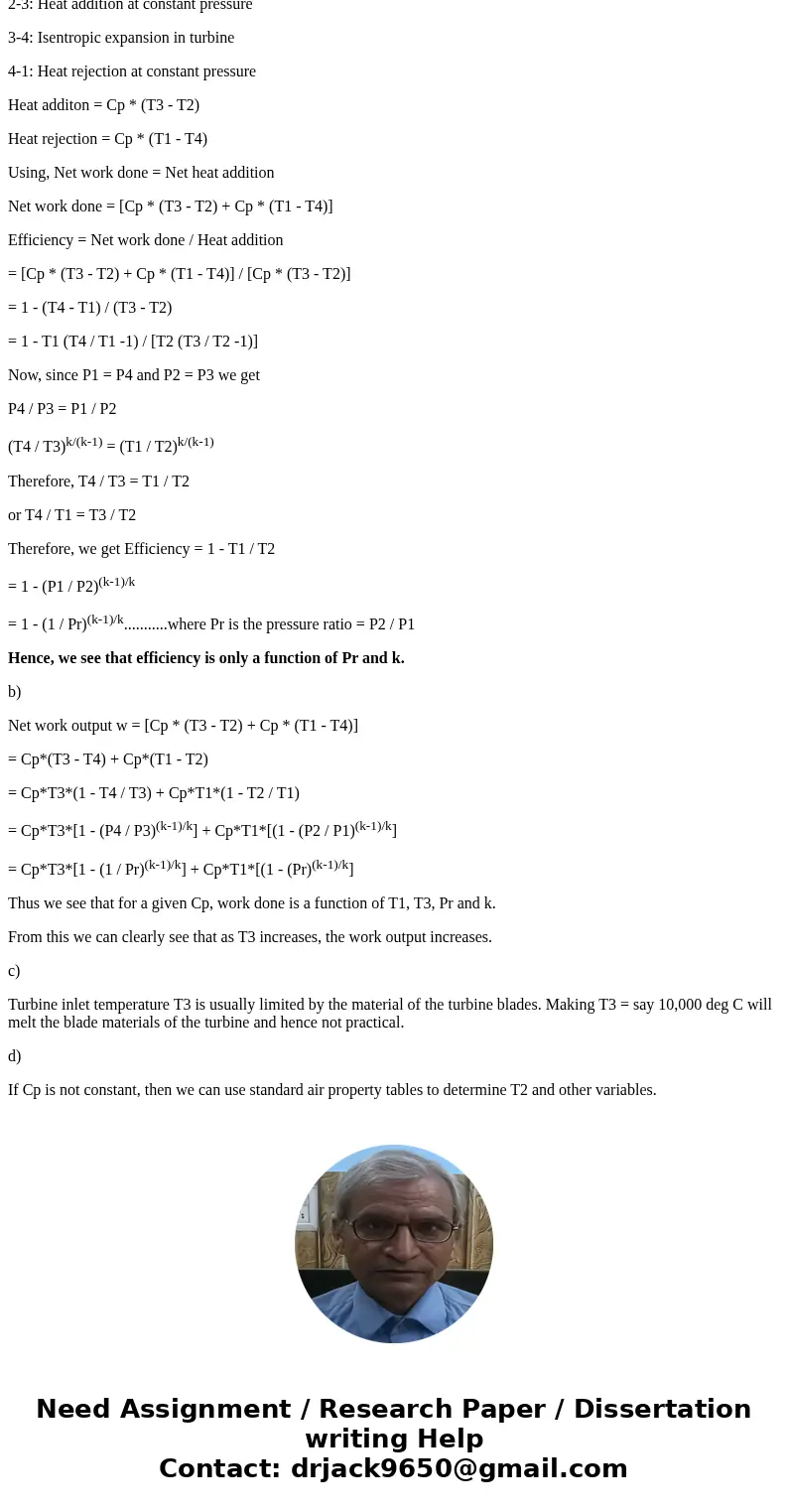a Write the equation for the efficiency of an ideal Brayton
a.) Write the equation for the efficiency of an ideal Brayton cycle and define each variable. (Note that efficiency is not a function of turbine inlet temperature, only pressure ratio and k.) Hint: Show that cycle = f (Pr, k)
b.) Write the equation for the output work/unit mass of air into the compressor for an ideal Brayton cycle. Define each variable. (Note that the amount of work from the cycle is dependent on the turbine inlet temperature, compressor inlet temperature, pressure ratio and k.) Hint: Show that Wout = f (Pr, k, T1, T3). Start with Wout = Wt – Wc. The purpose of Items 3 and 4 is to show that for an ideal Brayton cycle, cycle efficiency is only a function of Pr and k and not T3. However, the output work of the cycle for a given Pr, k and T1 increases as T3 increases. Note: for a non-ideal Brayton cycle, cycle efficiency is a function of T3.
c.) The above equation shows that we can get more work out of the cycle as turbine inlet temperature (TIT or T3) increases. Besides NOx emissions concerns, what limits the value of TIT? Hint: If Wout increases with T3, then why don’t we use very high T3, say 10,000 deg C? The reason we are limited to about 1200 deg C is the answer to c.
d.) If Cp is not constant we can use what type of tables to determine T2 if T1? Pr and k are known. Hint: There is a typo in this item. The variable “k” should be omitted since if Cp is not constant, then k will not be constant. Analyzing the Brayton cycle when Cp is not assumed to be constant is used when we want to get a more precise answer.
Solution
a)
Ideal Brayton cycle has 2 constant pressure process and 2 isentropic processes.
1-2: Isentropic compression
2-3: Heat addition at constant pressure
3-4: Isentropic expansion in turbine
4-1: Heat rejection at constant pressure
Heat additon = Cp * (T3 - T2)
Heat rejection = Cp * (T1 - T4)
Using, Net work done = Net heat addition
Net work done = [Cp * (T3 - T2) + Cp * (T1 - T4)]
Efficiency = Net work done / Heat addition
= [Cp * (T3 - T2) + Cp * (T1 - T4)] / [Cp * (T3 - T2)]
= 1 - (T4 - T1) / (T3 - T2)
= 1 - T1 (T4 / T1 -1) / [T2 (T3 / T2 -1)]
Now, since P1 = P4 and P2 = P3 we get
P4 / P3 = P1 / P2
(T4 / T3)k/(k-1) = (T1 / T2)k/(k-1)
Therefore, T4 / T3 = T1 / T2
or T4 / T1 = T3 / T2
Therefore, we get Efficiency = 1 - T1 / T2
= 1 - (P1 / P2)(k-1)/k
= 1 - (1 / Pr)(k-1)/k...........where Pr is the pressure ratio = P2 / P1
Hence, we see that efficiency is only a function of Pr and k.
b)
Net work output w = [Cp * (T3 - T2) + Cp * (T1 - T4)]
= Cp*(T3 - T4) + Cp*(T1 - T2)
= Cp*T3*(1 - T4 / T3) + Cp*T1*(1 - T2 / T1)
= Cp*T3*[1 - (P4 / P3)(k-1)/k] + Cp*T1*[(1 - (P2 / P1)(k-1)/k]
= Cp*T3*[1 - (1 / Pr)(k-1)/k] + Cp*T1*[(1 - (Pr)(k-1)/k]
Thus we see that for a given Cp, work done is a function of T1, T3, Pr and k.
From this we can clearly see that as T3 increases, the work output increases.
c)
Turbine inlet temperature T3 is usually limited by the material of the turbine blades. Making T3 = say 10,000 deg C will melt the blade materials of the turbine and hence not practical.
d)
If Cp is not constant, then we can use standard air property tables to determine T2 and other variables.


 Homework Sourse
Homework Sourse